QuestionI was wondering which would be easier to breed: bettas or corydoras. Would you be able to provide information on whichever one you think would be easier to breed? Thanks!
AnswerHi Marisol,
While both species (Corydoras and Bettas) are generally easy to breed. Corydoras could be considered easier because with bettas there is the aggression issues between the pair and it has to be only a certain time for them to actually spawn and things can often go wrong with the spawn or you may get a male betta who eats his eggs, neglects the bubblenest, or the pair just won't spawn ect...
With Cories, you don't have to wait like with bettas for the perfect time when the male has a bubblenest built and the female is receptive to spawning. With Corydoras you usually raise several of the same species in a group of at least 6. With this method you can sometimes get several males in the bunch, which is very good.
_The Spawning Tank_
A 10-gallon aquariums works wonderfully well for spawning corydoras. The aquarium can have a thin layer of substrate but can do fine without as well as a barebottom tank. A sponge filter or hang-on-the-back power filter is best for keeping the water clean and well-oxygenated. An aquarium heater should also be included to keep the temperature around 75-77 F.
Be sure to give the Cories a well-sheltered place to rest such as a brand new clay flower pot turned upside down with a notch in the rim big enough to allow the cories to enter easily. Cories love quiet and dark areas to rest in.
Plants are fine to use also, and can provide good places for cories to lay their eggs. They can be either live, plastic or silk. Broad leaved plants are especially good.
_Conditioning_
In order to get Corydoras into spawning condition, they'll need a variety of nutritous foods such as all kinds of worms either frozen or freeze dried, Brine shrimp, Daphnia, and other meaty frozne/freeze dried foods, as well as high-quality sinking bottom feeder pellets and tablets, algae wafers and flake food sunk to the bottom.
Like with all fish, water changes are extremely important. Changing at least 30% or more twice a week is best, you can always change it more often, and remember it's especially important to do so since they are being fed a rich diet.
_Triggering_
When conditioned properly and the catfish are healthy they may decide to spawn on their own and you may one day find tiny eggs stuck on the glass sides, plants and possibly decor. But most cories are influenced to spawn when you do a partial water change of 25-30% with cooler water than the tank. Use water that is several like 5-6 degrees cooler than the tank itself. It is said the addition of the cooler water induces cories to spawn because it duplicates a heavy rain in their natural habitat.
_The eggs and fry_
Corydoras eggs will generally hatch in 4-5 days and the fry like most egglaying fish, will feed upon their yolk sac for about 48 hours. During this time you don't need to feed them. During this time they will also tend to want to hide and it may be several weeks before they feel confident enough to swim about the aquarium freely. Once the egg yolk has been absorbed the fry will need to be fed. Microworms are often recommend, but you'll need to have those ready well-ahead of time before your cories spawn. Other people use fine-powdered flakes or special baby fish food which comes in a powder such as Hikari brand's first bites. You can also try frozen baby brine shrimp. Live baby brine shrimp may move too much for the cories. Infusoria is another microscopic live food that can be fed. Later once the babies get bigger you can start them on sinking foods like you feed the cories.
So that's pretty much it on the corydoras spawning. Although you don't have to worry about the aggression issues with Corydoras, sometimes things won't go as planned and you have to try something different. Sometimes cories won't spawn right away, so it's best to be patient and try one thing at a time and eventually they will certainly spawn.
With breeding bettas you'll need a special spawning tank of 5-10 gallons filled half-way, a styrofoam cup cut in half (for the male to build his bubblenest), a gentle air-driven internal filter or sponge filter, a heater, thermometer, some bushy plants either live of fake, and a glass chimney originally made for oil lamps, you should be able to find these at a hardware store. Placing this in the spawning tank provides your female betta with a safe and secure holding area so she can see the male and he can see her but they can't do harm.
With exceptional good food and frequent partial water changes the male will build a bubblenest and the female betta will ripen with eggs. When this happens the female is carefully released into the spawning tank. There can be a lot of displaying and aggression between the pair and there will be plenty of torn fins. This is normal. If you are lucky, eventually the male will entice the female under his bubblenest and she will swim up. Spawning should follow soon. Once the female has laid her eggs the male looks after the bubblenest up until the fry hatch and three days thereafter.
You'll need a microworm culture reading 3 weeks beforehand to feed the free-swimming fry.
I really hope this helps!!
Best of luck and happy fishkeeping!
Karen~
For more info on spawning bettas- please visit-
www.bettatalk.com

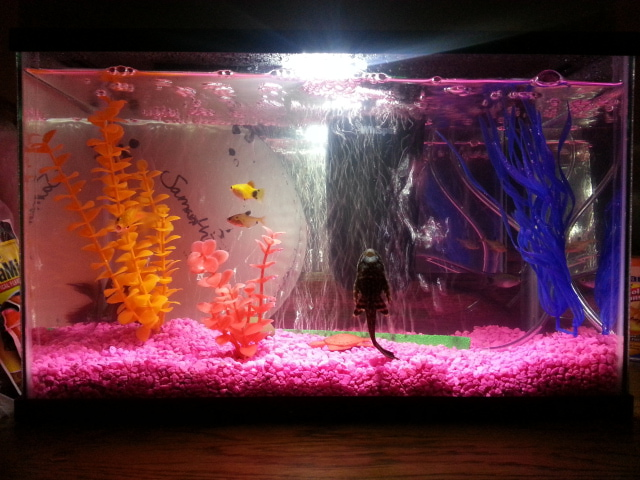 help! I have a new 5 gal tank & too many fish, I think
Question
aquarium
My daughter won 2 goldfish at
help! I have a new 5 gal tank & too many fish, I think
Question
aquarium
My daughter won 2 goldfish at
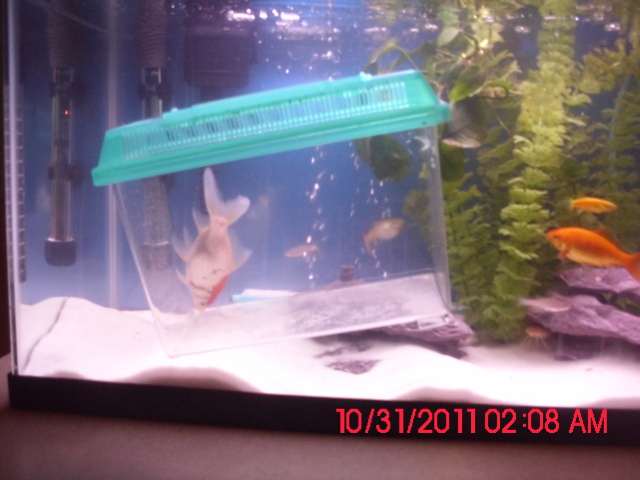 Facedown Gold fish
Question
face down gold fish
On firday i took my
Facedown Gold fish
Question
face down gold fish
On firday i took my
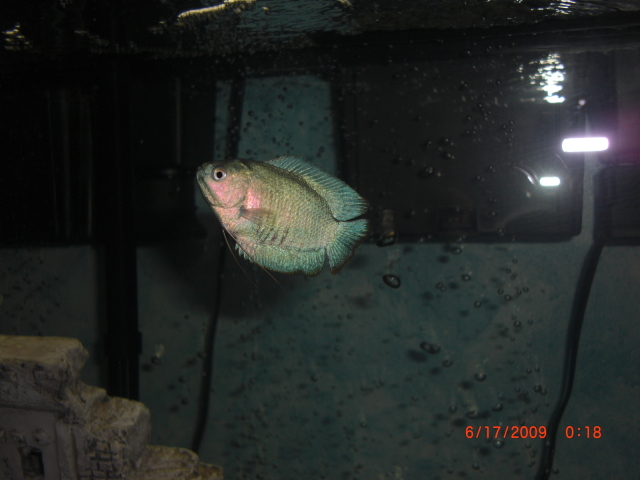 POWDER BLUE DWARF GOURAMI
Question
POWDER BLUE DWARF GOUR
HI. I JUST WANT TO KNOW
POWDER BLUE DWARF GOURAMI
Question
POWDER BLUE DWARF GOUR
HI. I JUST WANT TO KNOW
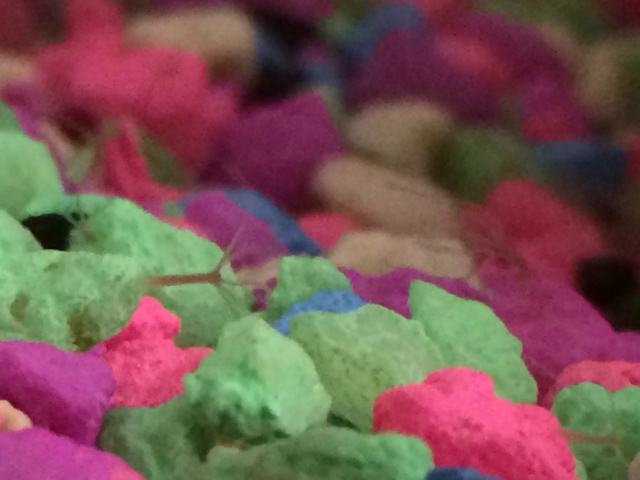 Whats in my tank?!?
Question
Squirming thing Squirming thing
T
Whats in my tank?!?
Question
Squirming thing Squirming thing
T
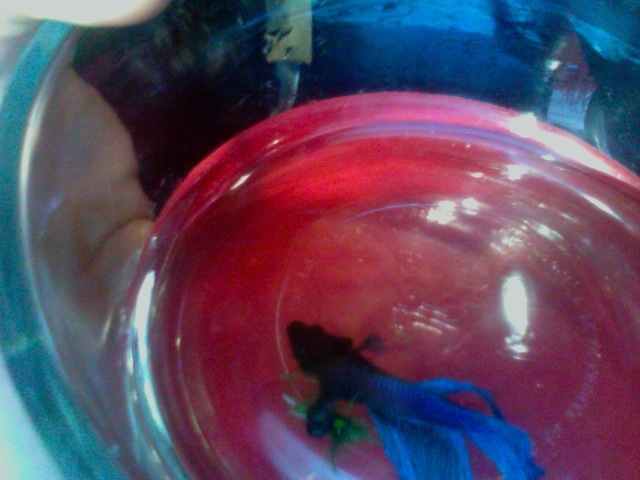 Betta fins tangles in hair algae
Question
betta with tangled ven
I came home today to fi
Betta fins tangles in hair algae
Question
betta with tangled ven
I came home today to fi